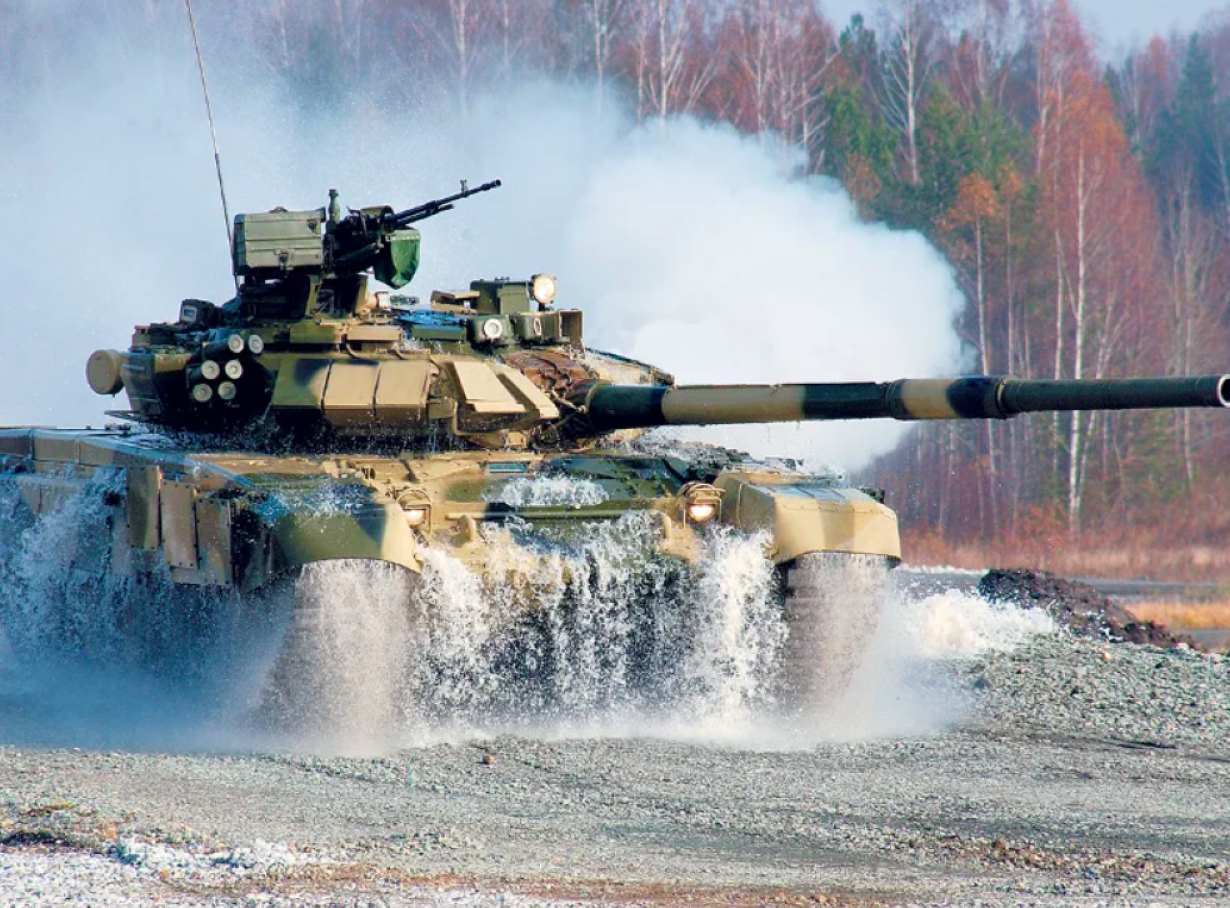The Indian Army has unveiled a hybrid of the Soviet-vintage T-72′ Ajeya’ tank and the Russian-origin T-90 ‘Bheeshma’ tank. The concept tank was displayed at the recently concluded ‘Know Your Army Festival’ exhibition at Lucknow before the run-up to Army Day on January 15.
Russian tanks are the mainstay of the Indian Armored fleet. Amidst its invasion of Ukraine, Russia has found it challenging to help India with the upgradation of its aging T-72 tanks as Moscow is also scrapping the end of the barrel to keep its armored power intact in the face of losses.
Developed by the Indian Army’s Corps of Electronics and Mechanical Engineers, the tanks fuse the T-72’s hull with the T-90s turret, creating a new tank.
As per the specifications, ‘Atharva’ weighs 45.8 tonnes. It is lighter than the T-90s but weighs more than the T-72s. The hybrid tank is powered by the V92S2 high-power multifuel engine that boasts 1,000 hp and has been specifically designed for the T-90 MBT.
This hybrid tank, which boasts more firepower than the original T-72, has also been reinforced with an Explosive Reactive Armour (ERA) initially developed by DRDO for the Arjun MBT. This hybrid tank, spotted while undergoing tests, is equipped with Cannon-fired ATGMs.
The F-4 Phantom was America’s foremost fighter, Richard Nixon was president, and the world’s steel beasts had not yet encountered a foe known as the wire-guided anti-tank missile when the Soviet T-72 tank was first put into action. India purchased more than 1800 of the T-72M1 tanks between 1982 to 1986.
The T-72 design has some fundamental shortcomings. First of all, the turret houses the ammo storage. If you get hit by an armor-piercing bullet and hit the ammunition, the turret will usually pop off and kill everyone. The Indian Army has embarked on a plan to upgrade the tanks; however, the turret limitation makes it challenging.
In the Atharva, the challenge has been overcome by merging T-90’s advanced turret with T-72’s sturdy hull. The T-90s turret also has domestically developed composite armor, a mixture of ceramic and other laminates, which may offer better protection than the stock T-90S, the Russian export model.
In addition to the T-72M1, the Indian Army operates two variants of the third-generation Russian T-90 MBT — the T-90S Bhishma and T-90SM (other designations T-90AM or T-90MS). The Indian Army has over 1,200 license-built T-90S Bhishma and T-90M MBTs. The T-90 was selected over the domestically developed Arjun MBT to counter the Pakistan military’s Ukrainian-made T-80 tanks.
In November 2023, the Indian Army issued a tender to support its program for the restoration and life extension of the T-72s in its fleet. The Overhaul II was aimed at restoring the tanks to “as good as new condition” by “100 percent replacement of parts that have limited shelf life such as gaskets, seals, rings, bearings, fasteners, washers, and so on; testing of assemblies; integration in tanks; and quality assurance”.
It is unclear if the Indian Army will proceed with the planned modernization. Reports indicate that Atharva has improved firepower and tactical capabilities compared to its parent tanks, but its ability to navigate steep gradients is on the lower side.
The Old Guards At Formidable Heights Against China
The Indian Army has fought some spectacular tank battles on its Western front with Pakistan. In Ladakh, amid the standoff with China, the heavyweight T-90 and T-72 tanks, developed in Russia, are in service.
With their capacity to combat chemical and biological weapons, India’s T-90 tanks are regarded as among the most lethal in the world.
In 2016, it was the second time in its history that the Indian Army deployed over 100 tanks to the frontline in Ladakh, located along the so-called Line of Actual Control (LAC) between India and China. Almost 60 years ago, in the face of the advancing Chinese army, the Indian Mechanized Division had airdropped five tanks in Ladakh.
The induction of the two regiments of T-72 tanks started in 2014. The Indian Army learned how to prepare the tanks in inclement weather where mercury plummets to -45 degrees Celsius.
The high altitude also makes the task arduous. The Indian military uses special lubricants and fuel to keep the tanks running, and at least twice every night, the engines are revved up to keep the systems in order.

Despite the annoying heights and extreme temperatures, the Depsang plains are flat and are suitable for armored battles. It is the critical point where Indian tanks could threaten the Aksai Chain at the eastern portion of the larger Kashmir region. It has also been the subject of the dispute between India and China since the 1962 border war was fought between them.
The entire territory spread from eastern Ladakh to the Tibetan plateau occupied by Chinese forces is suitable for tank operations. When the Chinese revved up their tanks after India took control of many heights close to the southern bank of Pangong Lake after August 29-30, 2020, the Indian armored regiments demonstrated their capacity to cross the LAC in minutes.
The T-90s, T-72s, and BMP-2 Infantry Combat Vehicles were deployed in Chumar, Chushul, and Depsang in 2020 following the Galwan clash. Unlike the Arjun, which is ideal for the hot conditions of India’s plains, the T-90MS variant was explicitly designed for the cold, harsh conditions of Ladakh, Sikkim, and Arunachal Pradesh in far north and eastern regions.
- Ritu Sharma has been a journalist for over a decade, writing on defense, foreign affairs, and nuclear technology.
- She can be reached at ritu.sharma (at) mail.com
- Follow EurAsian Times on Google News